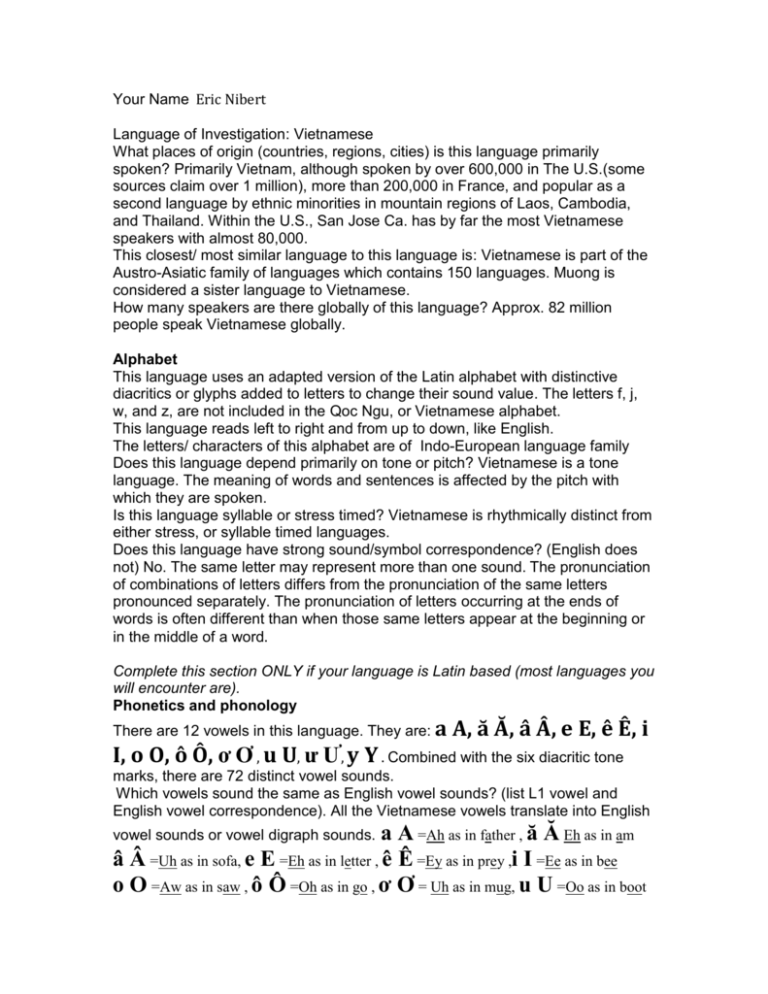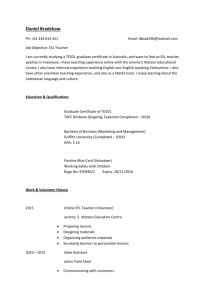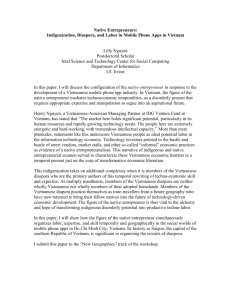Vietnamese_Analysis
advertisement

Your Name Eric Nibert Language of Investigation: Vietnamese What places of origin (countries, regions, cities) is this language primarily spoken? Primarily Vietnam, although spoken by over 600,000 in The U.S.(some sources claim over 1 million), more than 200,000 in France, and popular as a second language by ethnic minorities in mountain regions of Laos, Cambodia, and Thailand. Within the U.S., San Jose Ca. has by far the most Vietnamese speakers with almost 80,000. This closest/ most similar language to this language is: Vietnamese is part of the Austro-Asiatic family of languages which contains 150 languages. Muong is considered a sister language to Vietnamese. How many speakers are there globally of this language? Approx. 82 million people speak Vietnamese globally. Alphabet This language uses an adapted version of the Latin alphabet with distinctive diacritics or glyphs added to letters to change their sound value. The letters f, j, w, and z, are not included in the Qoc Ngu, or Vietnamese alphabet. This language reads left to right and from up to down, like English. The letters/ characters of this alphabet are of Indo-European language family Does this language depend primarily on tone or pitch? Vietnamese is a tone language. The meaning of words and sentences is affected by the pitch with which they are spoken. Is this language syllable or stress timed? Vietnamese is rhythmically distinct from either stress, or syllable timed languages. Does this language have strong sound/symbol correspondence? (English does not) No. The same letter may represent more than one sound. The pronunciation of combinations of letters differs from the pronunciation of the same letters pronounced separately. The pronunciation of letters occurring at the ends of words is often different than when those same letters appear at the beginning or in the middle of a word. Complete this section ONLY if your language is Latin based (most languages you will encounter are). Phonetics and phonology There are 12 vowels in this language. They are: a A, ă Ă, â Â, e E, ê Ê, i I, o O, ô Ô, ơ Ơ , u U, ư Ư, y Y . Combined with the six diacritic tone marks, there are 72 distinct vowel sounds. Which vowels sound the same as English vowel sounds? (list L1 vowel and English vowel correspondence). All the Vietnamese vowels translate into English a A =Ah as in father , ă Ă Eh as in am â Â =Uh as in sofa, e E =Eh as in letter , ê Ê =Ey as in prey ,i I =Ee as in bee o O =Aw as in saw , ô Ô =Oh as in go , ơ Ơ = Uh as in mug, u U =Oo as in boot vowel sounds or vowel digraph sounds. ư Ư =Ue as in hurry, y Y =Ee as in bee. Which vowel sounds do not exist in English? All of the sounds exist, but how they are spoken with different tones, sounds much different than English. There are 16 single letter consonants in this language. They are (cut and paste the consonants of the actual script) Bb, Cc, Dd, Đ đ, Gg, Hh, Kk, Ll, Mm, Nn, Pp, Qq, Rr, Ss, Tt, Vv, Xx. What sounds do speakers of this language have difficulty pronouncing?The ‘R’ , ‘J’ and ‘W’ sound don’t exist in Vietnamese. They also palatize some sounds moreso than in English, and breath is not released after final consonants. The th sound is never pronounced like it is in the word path.There is page after page describing how Vietnamese sounds different from English, using words like apico-alveolar and velar fricative. It’s not necessarily the sounds of the letters, but how the breath and position of the tongue play a part in forming the sounds, combined with constantly changing tones, that make the languages so different. Are there any sound placements that are different between English and this language? What are they? L only appears at the beginning of a word, and words c as in stack, ch Ch as in butch, m M as in spam, n N as in can, ng Ng as in spring, nh Ng as in spring, p P as in stop Plosive; as in bắp cải, t T as in tot. only end in the following consonants: Do any double letter combinations exist in this language? No. Syntax and Grammar How many tenses exist in this language? Vietnamese does not mark tense. Vietnamese relies on word order and tone. Intensity of a word and pluralism can be shown by reduplicating the whole or part of a word(saying the word twice). The word order of this language is? Sentences in Vietnamese have subject-verbobject word order. Because there is so little inflection, the language depends on strict word order to convey meaning. What are the punctuation forms used in this language? List using English comparisons. Punctuation is very similar to English, however, apostrophes are not used, titles are in all capitals, and quotations are used a little differently. The person speaking is identified first, followed by a colon then the quotation. For example: "Would anyone like some tea?", asked George - George hỏi: "Có ai muõn dùng trà không?" How does this language mark gender? It doesn’t mark gender. Morphology What are some shared cognates between English and this language? Vietnamese shares many cognates with Chinese but very few, if any, with English. What are some FALSE cognates between English and this language? I could find none. Through your research what have you found are the biggest difficulties of speakers of this language learning English? Please provide specific examples. In Vietnamese there are only a limited numer of sounds that can end words, therefore ELLs often have trouble pronouncing the final consonants. There are also sounds in the English language not found in Vietnamese, and 80% of Vietnamese words are mono-syllabic and word order is different and very strict. The most difficult aspect for Vietnamese learners is how different a tone language is to English. Their L1 uses six diacritic marks to show tone, which also shows meaning. The Vietnamese word ‘Ma’ for example, can mean six different things depending on the tone. Ma with no marks uses a level tone and means ‘ghost’, má with an acute accent has a sharp tone and means ‘mother’, mà with a grave accent has a hanging tone and means ‘but’, mả with a hook has an asking tone and means ‘tomb’, mã with a tilde mark has a tumbling tone and means ‘code’, and mạ with a dot has a heavy tone and means ‘seed’. I listened to a tutorial which demonstrated how the word ‘ma’ sounds using each different tone, and it was difficult to distinguish a significant difference in the different tones. It must be very difficult to unlearn using tones as meaning. If you have an early production ELL who this language is their L1, what would be the most important thing you will teach them in regards to the difference between their language and English? There a few different things I would focus on: beginning and ending consonants are often a problem because Vietnamese don’t aspirate certain letters such as a beginning or ending /t/, which makes it sound like they’re saying /d/, and /k/ often sounds like /g/. The biggest problem is transitioning from a tonal language to one that uses tense and plurals and has many polysyllabic words. Vietnamese learners need help learning intonation and inflection as well.
![vietnam[1].](http://s2.studylib.net/store/data/005329784_1-42b2e9fc4f7c73463c31fd4de82c4fa3-300x300.png)




